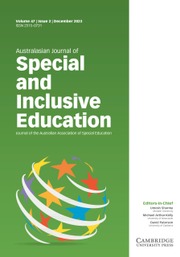Article contents
A Preliminary Study of Students With Disabilities in ‘Flexi’ Education Settings
Published online by Cambridge University Press: 12 April 2021
Abstract
Flexible learning programs (FLPs) provide a place for students who have disengaged and disconnected from mainstream schools. Despite the legislative framework in Australia supporting the participation of students with disability in their local mainstream schools wherever possible, very little research focusing on whether students with disability are being excluded from, or dropping out of, mainstream schools into these FLPs has been conducted. In this paper, we report on the findings of an online cross-sectional survey of FLP leaders about their student populations, with a focus on the 10 most prevalent disabilities among Australian children. Data from the 22 participants who completed all items of the survey were analysed. The participants’ (n = 22) schools represented a total enrolment of 2,383 students in FLPs across Australia: Tasmania (n = 3), Victoria (n = 5), New South Wales (n = 5), Queensland (n = 4), Western Australia (n = 3), and South Australia (n = 2). We found that while there was an apparent overrepresentation of students with certain types of disabilities in FLPs, others were not overrepresented at all. The findings of this preliminary study are discussed, with an exploration of issues relating to why students with some disabilities may be more likely to disengage, or be excluded, from mainstream schooling while others are not, as well as recommendations for future research.
- Type
- Original Articles
- Information
- Australasian Journal of Special and Inclusive Education , Volume 45 , Issue 1 , July 2021 , pp. 76 - 89
- Copyright
- © The Author(s), 2021. Published by Cambridge University Press
Footnotes
This manuscript was accepted under the Editorship of Umesh Sharma.
References
- 7
- Cited by


